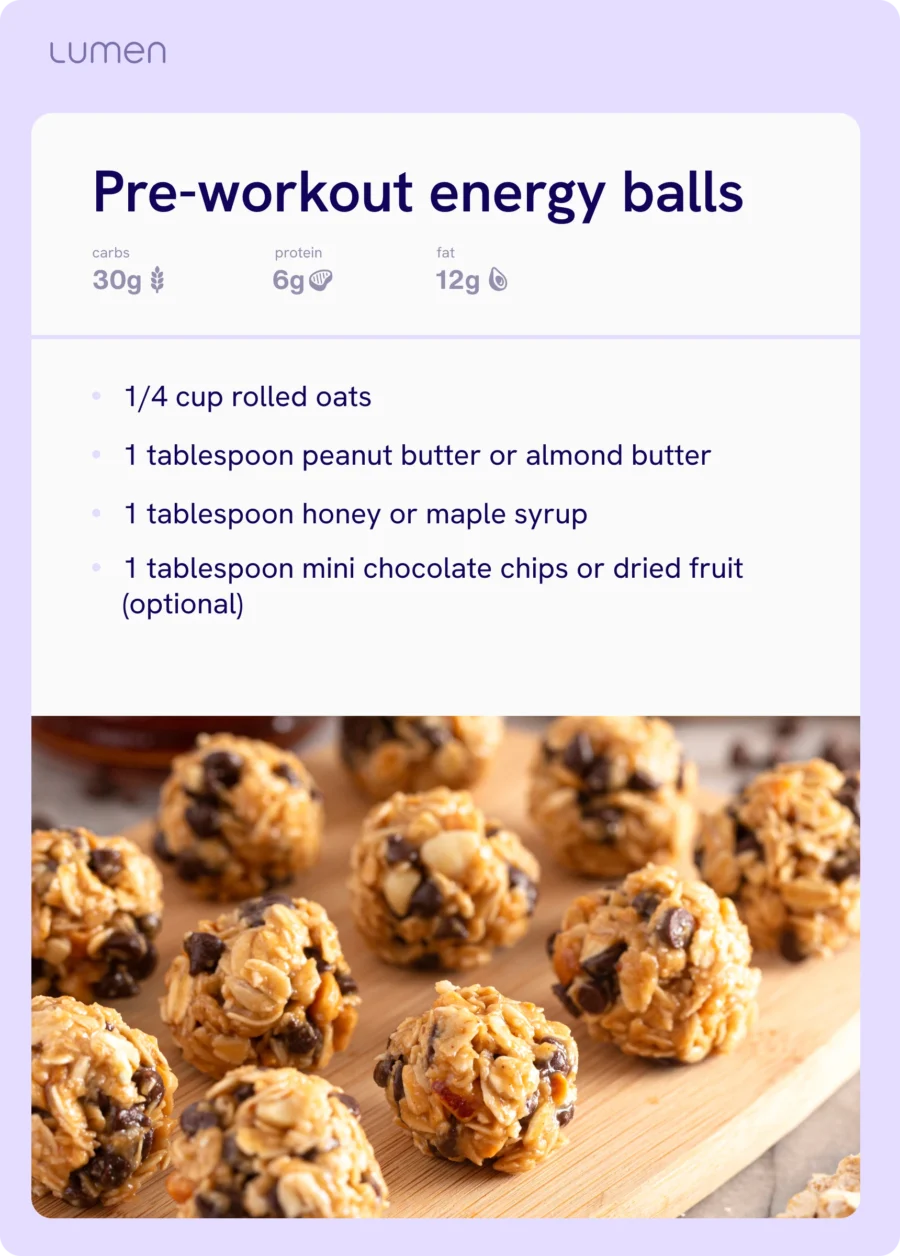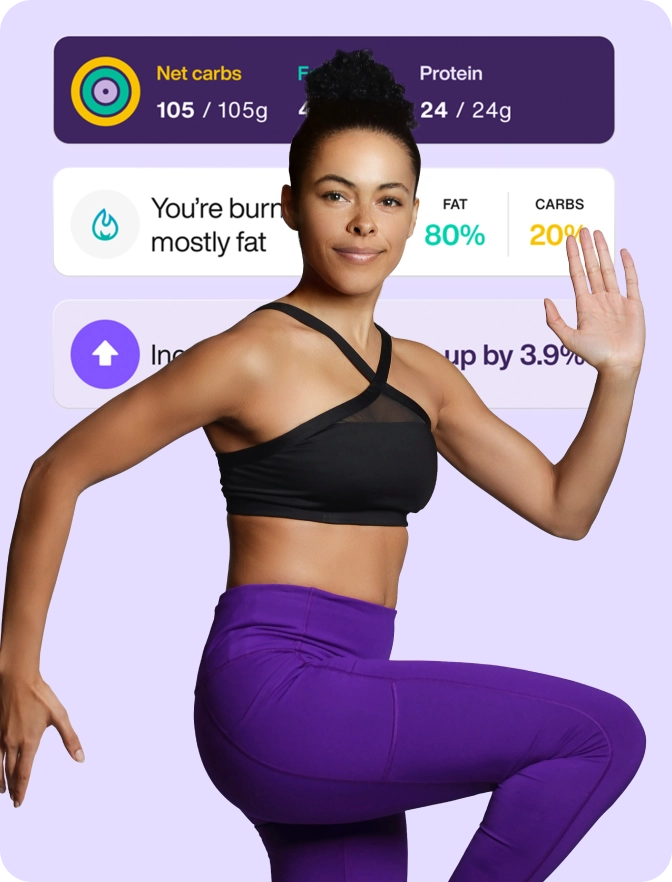Are your pre-workout meals worked out?

Dietitians and nutritionists often receive questions about pre- and post-workout nutrition. While answers can vary based on individual needs and activities, there are common guidelines. Pre-workout snacks should be enjoyable and beneficial, providing energy and preparing muscles for the exercise ahead. Post-workout nutrition is essential for refueling, recovery, and muscle growth.
Eating the right foods before and after workouts is crucial because it provides the optimal fuel for the mitochondria, the powerhouses of your cells, to produce energy. To function efficiently, the mitochondria need both carbs and fats as fuel. When the mitochondria can easily switch between burning carbs or fats, depending on their availability and your body’s needs, it makes you metabolically flexible.
This has many benefits, such as enhanced athletic performance, muscle mass growth, and better body composition.
The importance of exercise
Exercise is a cornerstone of a healthy lifestyle, providing numerous benefits beyond physical appearance. Regular physical activity improves cardiovascular health, enhances mood, supports weight management, and strengthens muscles and bones. Understanding the different types of exercise and how they impact our bodies is crucial for optimizing our workout routines and nutritional strategies.

Aerobic vs. anaerobic workouts
Exercise can generally be categorized into two main types: aerobic and anaerobic workouts. Each type serves different purposes and offers distinct benefits.
Aerobic workouts
Aerobic exercise, also known as cardio, involves sustained, rhythmic activities that increase your heart rate and breathing. These workouts rely on the continuous use of oxygen to generate energy through aerobic metabolism. During aerobic exercise, the body uses carbohydrates and fats as the primary energy sources, converting them into ATP (adenosine triphosphate) with the help of oxygen. Fat is typically used as fuel by the mitochondria during prolonged low-intensity exercise like walking. Common examples of aerobic exercises include:
- Running or jogging
- Swimming
- Cycling
- Brisk walking
Aerobic workouts are typically low to moderate-intensity activities performed over an extended period. They effectively improve cardiovascular health, enhance lung capacity, and boost endurance.

Anaerobic workouts
Anaerobic exercise consists of short, intense bursts of activity where the oxygen demand exceeds the supply available. These workouts rely on glucose stored in the muscles as glycogen. During anaerobic metabolism, glycogen is broken down into glucose, which is then used to produce ATP (adenosine triphosphate) through glycolysis. This process does not require oxygen for energy and results in lactate production, which can accumulate in the muscles and cause the characteristic "burn" associated with intense exercise. Common examples of anaerobic exercises include:
- Weightlifting
- Sprinting
- High-intensity interval training (HIIT)
- Jumping rope
Anaerobic workouts are typically high-intensity activities performed in short durations. They are effective for building muscle strength, power, and muscle mass and improving overall body composition.
Impact on health and well-being
Both aerobic and anaerobic exercises contribute to various aspects of health and well-being. Here’s how they impact key areas:
Cardiovascular support
Aerobic exercise is particularly beneficial for cardiovascular health. It strengthens the heart muscle, improves blood circulation, and lowers blood pressure. Regular aerobic activity can reduce the risk of heart disease, stroke, and hypertension.
Anaerobic exercise also supports cardiovascular health by enhancing the efficiency of the heart and lungs during high-intensity efforts. This training can improve the body’s ability to manage and recover from intense physical exertion.
Mitochondrial health
Mitochondria play a crucial role in energy production. Both aerobic and anaerobic exercises stimulate mitochondrial biogenesis, increasing the number and efficiency of mitochondria in the muscles1. This leads to better energy production, improved endurance, and overall cellular health. Your muscles are packed with mitochondria. So, the more muscle mass you gain through anaerobic training, the more mitochondria you’ll have. This translates to increased fat burn at rest and a quick shift to carb burn when you need a little boost.
Body recomposition
Aerobic exercise primarily aids in fat loss by increasing energy expenditure. With the appropriate diet, it can help you achieve a leaner body composition.
Anaerobic exercise, particularly resistance training, is vital for building and preserving muscle mass. It promotes a higher resting metabolic rate, aiding long-term weight management and body recomposition.
Mood balance
Exercise, in general, is known to enhance mood and reduce symptoms of depression and anxiety. Aerobic exercise releases endorphins, often referred to as "feel-good" hormones, which can improve mood and promote relaxation.
Workout nutrition
Pre-workout nutrition
Pre-workout nutrition is important to ensure the body has enough energy to perform effectively, especially during high-intensity workouts. Consuming carbs before exercising helps balance your glycogen stores to maximize performance, delay fatigue, and improve endurance. When glycogen is depleted, your mitochondria won't have the reserves to provide energy boosts, leaving you feeling sluggish. Carbohydrates provide the necessary fuel for the body, while protein helps prepare the muscles for the stress of training, reducing the risk of injury and enhancing muscle repair and growth.
Timing: Eat 1 to 4 hours before exercising to avoid gastrointestinal discomfort and performance issues.
Carbohydrates: Essential throughout the workout, breaking down into glucose for energy.
Protein: Small, easy-to-digest portions to help repair muscle micro-tears.
Hydration: Proper hydration with 250-350mL of water pre-workout and 20-30mL in small sips during exercise.
Post-workout nutrition
Post-workout nutrition directly impacts recovery, muscle growth, and overall performance. During exercise, especially intense or high-endurance sessions, the body’s glycogen stores are depleted. Consuming carbohydrates post-workout is essential to replenish glycogen stores, ensuring the body has enough energy for subsequent activities. Additionally, protein intake is vital for repairing and rebuilding muscle fibers that break down during exercise. For workouts that are extremely energy-demanding, replacing expended energy with fat is important to restore energy balance. Proper fueling helps avoid muscle breakdown, reduces the risk of fatigue and injury, and supports continuous improvement in fitness and strength.
- Importance: Essential for recovery, especially after workouts longer than 60 minutes or strength-based sessions.
- Timing: Short, moderate workouts: Can wait until the next meal.
- Longer workouts: A combination of carbs and a protein-rich meal or snack within 2 hours after the workout. If the workout demands high energy, fat should also be consumed.
- Rehydration: 500-750mL of water depending on sweat and environmental conditions.
How Lumen helps you find the right workout nutrition
Lumen supports users with finding the proper workout nutrition. By taking measurements before and after a workout, Lumen can help you determine the right nutrition based on the workout type and measurement results. For anaerobic workouts, starting with a high Lumen level is best, ensuring you have enough energy for the workout.
Conversely, aerobic workouts can be performed starting with a lower Lumen level, depending on the purpose. If the aim is to reach fat burn quickly and for a prolonged period, you can start the workout with a lower Lumen level and may not need to fuel up beforehand. However, if you plan to engage in high-endurance training, eating some carbs before the workout can be beneficial.
After a workout, post-workout breath measurements will help determine how many macros you should consume to best recover from your session.
Pre-workout meals
Oatmeal with berries and nuts
- 1/2 cup oats
- 1 cup milk (any type, assuming 2% milk for calculation)
- 1/2 cup fresh berries (blueberries, strawberries, raspberries)
- 2 tablespoons nuts (almonds or walnuts)
- 1 teaspoon honey
Macros: 17g fat, 54g carbs, 16.5g protein
Greek yogurt with fruit and granola
- 3/4 cup Greek yogurt
- 1/2 cup fresh fruit (bananas, apple, or berries)
- 1/4 cup granola
- 1 teaspoon chia seeds
Macros: 11g fat, 50g carbs, 20g protein
Whole-grain toast with avocado and egg
- 1 slice whole-grain toast
- 1/2 avocado, mashed
- 1 boiled or poached egg
- A pinch of salt and pepper
Macros: 22g fat, 30g carbs, 15g protein
Pre-workout snacks
Banana and almond butter
- 1 medium banana
- 1 tablespoon almond butter
Macros: 9g fat, 34g carbs, 3g protein
Pre-workout energy balls
- 1/4 cup rolled oats
- 1 tablespoon peanut butter or almond butter
- 1 tablespoon honey or maple syrup
- 1 tablespoon mini chocolate chips or dried fruit (optional)
Macros: 12g fat, 30g carbs, 6g protein

Post-workout meals
Grilled chicken with quinoa and vegetables
- 3 ounces grilled chicken breast
- 1/2 cup cooked quinoa
- 1 cup steamed or roasted vegetables (broccoli, carrots, or bell peppers)
Macros: 10g fat, 45g carbs, 30g protein
Salmon with sweet potato and asparagus
- 3 ounces baked or grilled salmon
- 1/2 medium roasted sweet potato
- 1 cup steamed asparagus
Macros: 18g fat, 30g carbs, 30g protein
Turkey and avocado wrap
- 1 whole-grain wrap
- 3 ounces sliced turkey breast
- 1/2 avocado, sliced
- 1 cup leafy greens (kale, spinach, or arugula)
- 1 teaspoon olive oil or pesto
Macros: 18g fat, 30g carbs, 28g protein
Egg and veggie scramble
- 2 large eggs or 4 egg whites
- 1 cup sautéed vegetables (bell peppers, onions, tomatoes, and spinach)
- 1 slice whole-grain toast
Macros: 15g fat, 30g carbs, 20g protein
Post-workout snacks
Greek yogurt with honey and berries
- 3/4 cup Greek yogurt
- 1 teaspoon honey
- 1/2 cup fresh berries (blueberries, strawberries, or raspberries)
Macros: 4g fat, 25g carbs, 15g protein
Apple slices with peanut butter
- 1 medium apple, sliced
- 2 tablespoons all-natural peanut butter
Macros: 250 calories, 16g fat, 28g carbs, 6g protein
Post-workout smoothie
- 1/2 cup low-fat Greek yogurt
- 1 cup almond milk or milk of choice
- 1 handful spinach or kale
- 1/2 avocado
- 1 banana and 1/2 cup frozen berries (or fruit of choice)
Macros: 10g fat, 35g carbs, 10g protein
Cottage cheese with pineapple
- 1/2 cup cottage cheese
- 1/2 cup fresh or canned pineapple chunks
Macros: 200 calories, 4g fat, 30g carbs, 12g protein
Hummus with carrot and cucumber sticks
- 1/4 cup hummus
- 1 cup fresh carrot sticks
- 1 cup fresh cucumber sticks
Macros: 200 calories, 10g fat, 25g carbs, 5g protein
For more pre-workout and post-workout meal and snack ideas, check out our guide.

Additional tips
Ensure meals and snacks include carbohydrates to maintain energy levels and prevent the body from resorting to gluconeogenesis, the synthesis of glucose from non-carbohydrate sources, which can elevate Lumen levels.
You can adjust the amount of workout carbs based on your energy levels and hunger cues. Listen to your body to find the right balance for optimal performance and recovery.
Get your workout nutrition in order to maximize results
Whether you’re engaged in aerobic or anaerobic exercise, knowing how to fuel your body before and after your workout is vital to get the most out of your session and recover properly after.
Pre- and post-workout nutrition is the answer to unlocking more energy to power through your training, build muscle, improve body composition, and prevent injury. Get into the habit of measuring your metabolism before and after your workout to figure out how to best fuel your own body.







 Digital download
Digital download 


